How to Start Lifting Weights—Even if You've Never Held a Dumbbell Before
It’s easier than you think to start strength-training with weights.
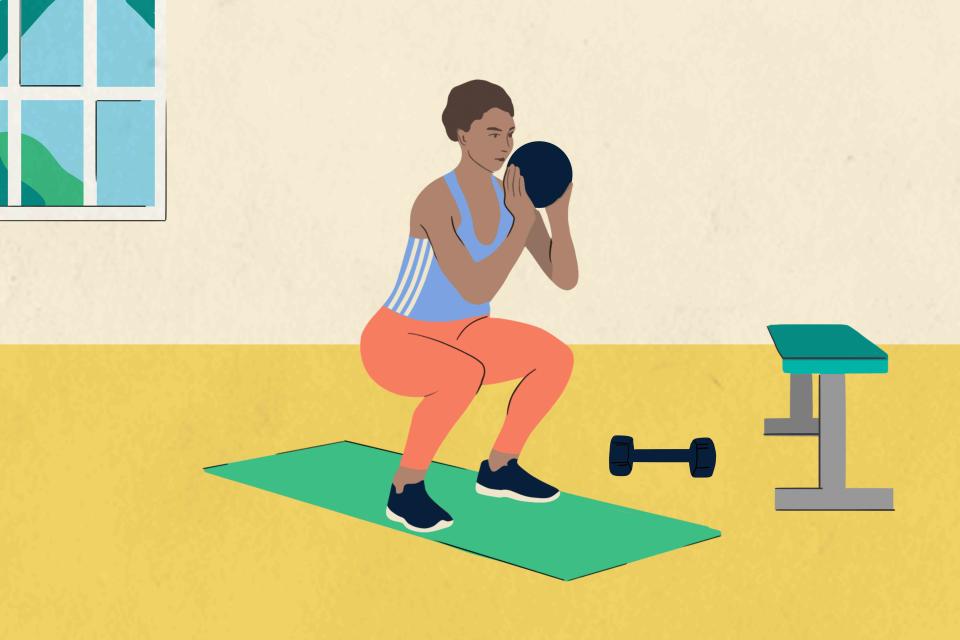
Caitlin-Marie Miner Ong
Aerobic and bodyweight exercises are fantastic, but if you don’t already exercise with added weight (or resistance bands!),then you’re missing out on some serious health benefits. Most of us should be getting in at least two days of strength training per week that hits all of your major muscle groups, including legs, hips, back, abdomen, chest, shoulders, and arms.
Lifting weights doesn’t just enhance your quality of life (yes, lugging grocery bags from the car will, in fact, be easier), but “strength training is very important, more so than cardio, for long-term health and longevity,” says Stacy T. Sims, Ph.D., exercise physiologist and nutrition scientist. Plus, as we age, we start to lose that good-for-you muscle, making it all the more important to maintain it. In fact, Sims notes, “if you’re not strength training, you can lose up to 50 percent of your lean skeletal body mass by your 80th birthday.”
For anyone who’s never even looked at the rack of dumbbells at the gym, don’t worry. While this may be an inspirational wakeup call to start lifting weights, know that it’s completely understandable to feel intimidated by it all. But that’s just because it’s unfamiliar—promise! To help break it down and make everything easier, we’ve rounded up some pro training tips to guide you, a few basic weight exercises to start with, and all the healthy perks you’ll get from doing them.
:Balance Declines as We Age—Here Are 8 Helpful Exercises for Lasting Stability
Weight Lifting Health Benefits
Promotes Longevity and Disease Prevention
Lifting weights isn’t just about building muscle—that’s the small picture. The big picture is everything else it can do for you. For starters, it can help extend your life. According to a systemic review and meta-analysis of 16 studies in the British Journal of Sports Medicine, shoring up your muscles via traditional weights or resistance bands can lower your risk of all-cause mortality by 10 to 17 percent. The same study also revealed that weight-lifting can decrease the risk of non-communicable diseases including total cancer, diabetes, lung cancer, and cardiovascular disease.
Boosts Heart Health
Speaking of your heart, weight-training—especially when working your bigger muscle groups— can actually be a good way to bump up your heart rate for a nice hit of cardio, says David N. Smith, M.D., FACC, cardiologist at Premier Cardiovascular Care in Charlotte, N.C., and clinical assistant professor at the Yale School of Medicine. This makes your body more efficient at pulling oxygen from the circulating blood which reduces the overall strain on the heart.
Improves Sleep
Weight-training will also help you get the good sleep you rightfully deserve, which about 70 million Americans don’t get, thanks to chronic sleep problems. A study in Preventive Medicine Reports found that muscle-strengthening was associated with a reduced prevalence of sleep rated as “poor” or “very poor,” even after adjusting for things like high body mass index, chronic disease, age, and smoking.
That’s big news considering a lack of quality sleep can put you at an increased risk for stroke, heart disease, and high blood pressure along with increased irritability or development of anxiety or depression.
Supports Mental Health
There are mental benefits to be gained as well. A 2018 meta-analysis in Jama Psychiatry revealed that time in the weight room can act like an antidepressant, reducing symptoms in adults.
How to Lift Weights: Safety Tips and Basics
Begin by using your own body weight.
While heading straight to the weight rack for the heaviest kettlebell might be your first instinct, take a pause. If you’re a strength-training newbie, it’s actually best to begin with your own body weight. “Your body already provides resistance—weights are just more resistance,” says Frank Baptiste, CSCS, certified strength and conditioning specialist and founder of FranklyFitness.
“For beginners who want to start weight training, a great approach that's sustainable and accessible no matter what they have access to is calisthenic workouts that involve their own body weight,” agrees Percell Dugger, a Nike running coach and certified strength coach.
Dugger recommends exercises such as push-ups, sit-ups, air squats, as well as any version of an isometric hold (think: planks, wall sits, and split lunges). After you’ve mastered body-weight moves and properly progressed with those exercises, “you can transition to more traditional strength-training exercises with weight and load,” Dugger says.
:5 Isometric Exercises to Help Build Strength and Balance
Progress to light weights.
Once you start incorporating weights, you’ll often still be performing many of the same moves as Dugger mentioned above, just with additional resistance (a.k.a weight!).
Baptiste recommends adding these five specific dumbbell weights into your routine. For your starting weight, he suggests using dumbbells (or other weights) you can lift 10 to 15 times (or reps). “If you can’t do [the exercise] 10 times, it’s too heavy,” he says. “If you can do it more than 20 times, it’s too light.”
Prioritize correct form over everything.
Using only your body weight and then light weights first will give you time to nail proper form for whatever strength exercise you’re doing, from bicep curls to weighted squats. Establishing the basics of proper form is key, especially as you go up in weight, not only for optimizing results, but for keeping you safe and injury free, Sims adds. If you can’t maintain good form while lifting a certain weight, it’s too heavy—go with a lighter weight that allows you to master that move with correct form.
Ask a professional trainer.
If you want to and can, Sims highly recommends investing in a few sessions with a trainer or coach, or going to a gym where the staff is well certified and qualified, in order to learn the basics of proper form, get helpful physical cues, learn your way around the different weights and machines, and other pro tips.
Basic Weight-Lifting Exercises to Get You Started
Goblet Squat
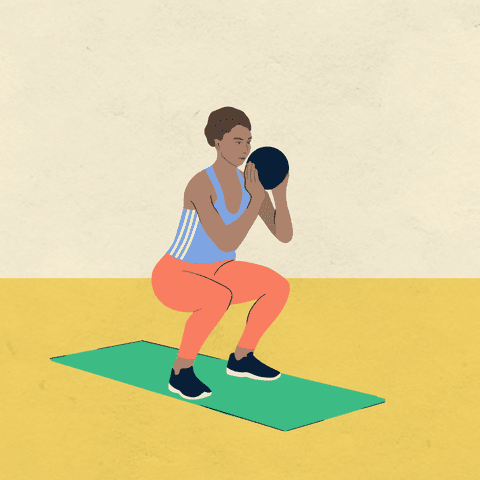
Caitlin-Marie Miner Ong
Stand tall holding a weight (dumbbell, kettlebell, weighted ball) in both hands at chest level with elbows bent and pointed down. Feet should be wider than hip-width apart and toes turned out slightly. Hinge at hips, push butt back behind you, and sink down into a squat; keep chest up and knees vertically stacked over ankles as much as possible. Press into feet, engage core, and squeeze glutes to rise back to standing.
Bent-Over Row
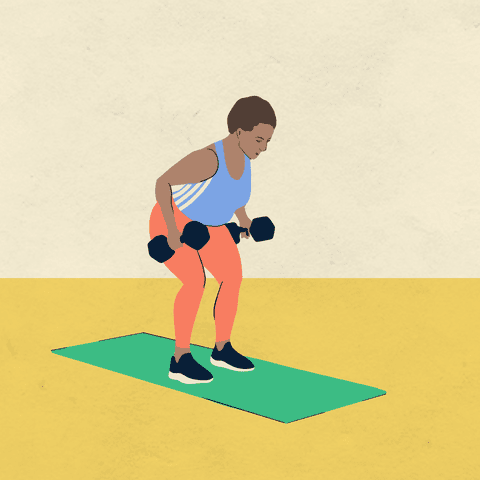
Caitlin-Marie Miner Ong
Stand with feet hip-width apart, a slight bend in knees, and a dumbbell in each hand down by your sides; palms face in. Hinge at the waist (think of sending butt back behind you rather than down) and lower torso slightly, allowing arms to hang down. Keep a strong, neutral spine (not rounded forward or arched back), squeeze shoulder blades, bend elbows, and draw dumbbells up to your sides. Slowly lower arms back to the start.
Weighted Stationary Lunge

Caitlin-Marie Miner Ong
Holding a dumbbell in each hand, stand with one foot a couple of feet in front of the other. Bend knees and lower down until both knees are at 90 degrees; the back knee should hover just above the ground. Push into the front foot to rise back to standing. After desired reps, repeat steps with the opposite leg in front.
Dumbbell Step-Up
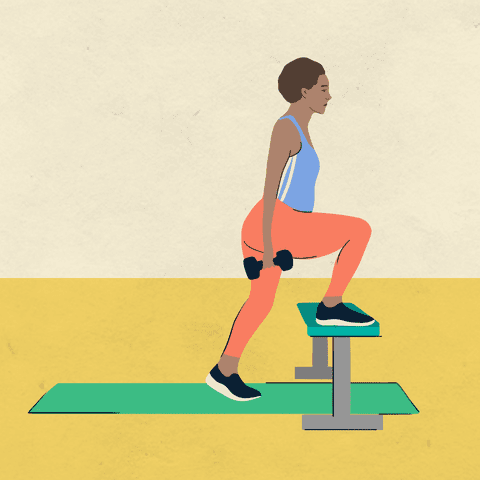
Caitlin-Marie Miner Ong
Start with a dumbbell in each hand and your right foot on top of a box, step, or bench. With core engaged and torso tall, step left foot up, straighten right leg to rise to standing on step. Keeping shoulders down and head up, reverse motion to lower left leg down slowly to the ground. After desired reps, repeat on the other side.
Bench Press
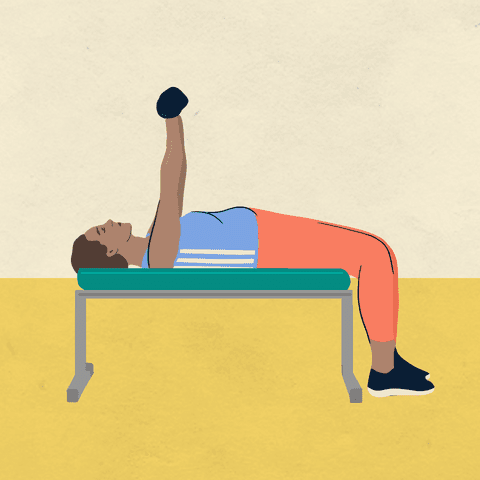
Caitlin-Marie Miner Ong
Lie face up on a workout bench, or the floor, with knees bent and feet flat on the floor. Hold a dumbbell in each hand with palms facing forward and elbows on the floor (or in line with shoulders if on a bench) bent at 90 degrees so the weights are in the air. This is your starting point. Press weights up until elbows are straight. Pause, and then slowly bend your elbows back to the starting position.
For more Real Simple news, make sure to sign up for our newsletter!
Read the original article on Real Simple.

 Yahoo Movies
Yahoo Movies 
